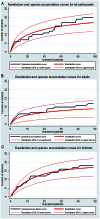Comparative population structure of Plasmodium falciparum circumsporozoite protein NANP repeat lengths in Lilongwe, Malawi
- PMID: 23771124
- PMCID: PMC3683670
- DOI: 10.1038/srep01990
Comparative population structure of Plasmodium falciparum circumsporozoite protein NANP repeat lengths in Lilongwe, Malawi
Abstract
Humoral immunity to Plasmodium falciparum circumsporozoite protein is partly mediated by a polymorphic NANP tetra-amino acid repeat. Antibody response to these repeats is the best correlate of protective immunity to the RTS,S malaria vaccine, but few descriptions of the natural variation of these repeats exist. Using capillary electrophoresis to determine the distribution of NANP repeat size polymorphisms among 98 isolates from Lilongwe, Malawi, we characterised the diversity of P. falciparum infection by several ecological indices. Infection by multiple distinct variants was common, and 20 distinct repeat sizes were identified. Diversity of P. falciparum appeared greater in children (18 variants) than adults (12 variants). There was evidence of genetic distance between different geographic regions by Nei's Standard Genetic Distance, suggesting parasite populations vary locally. We show that P. falciparum is very diverse with respect to NANP repeat length even on a local level and that diversity appears higher in children.
Figures




References
-
- World Health Organization. World Malaria Report 2012. WHO Publications: Geneva, (2012).
-
- RTS,S Clinical Trials Partnership. First results of phase 3 trial of RTS,S/AS01 malaria vaccine in African children. New Engl J Med. 365, 1863–1875 (2011). - PubMed
-
- Calvo-Calle J. M. et al. Immunogenecity of multiple antigen peptides containing B and non-repeat T cell epitopes of the circumsporozoite protein of Plasmodium falciparum. J Immunol. 150, 1403–1412 (1993). - PubMed
Publication types
MeSH terms
Substances
Grants and funding
LinkOut - more resources
Full Text Sources
Other Literature Sources

